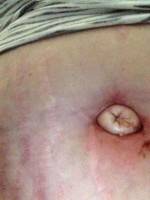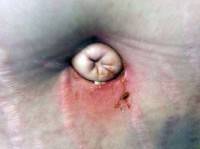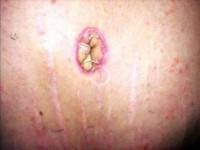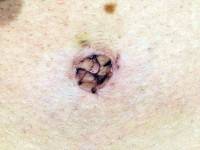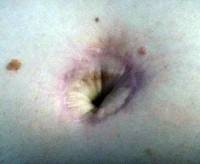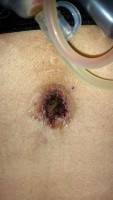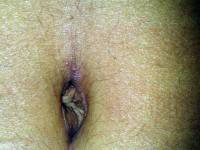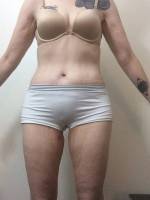Belly button after tummy tuck
Belly Button Scar Treatment
The belly button after tummy tuck is prone to form some thickened scar tissue in some patients. From the photos, it appears that some hypertrophic scar or early keloid formation has started to form.
This should be treated. In a patient of color, one has to be careful with the injection of kenalog or steroid into the scar.
I would combine injection of very dilute kenalog with compression therapy.
Many plastic surgeons do not compress the belly button after tummy tuck, but I have had good experience with the use of a plastic bead. The bead should fit snugly into the belly button.
If snug, it will compress a portion of the scar which is thickened. This can be combined with the very dilute steroid injection. The steroid should be very dilute because lightening of skin pigmentation can occur with patients of color. It may be helpful to ask your plastic surgeon about these options. (Stephen Bresnick, MD, Los Angeles Plastic Surgeon)
Unfortunately, due to your genetic issues, you have developed hypertrophic (thick) scars that are also hyperpigmented (dark). This can be very difficult to treat.
Early use of scar creams and silicone gel sheeting can help many though not all. At this point in time, consideration can be given for very careful, low dose steroid injections particularly around the belly button after tummy tuck. This is a double edged sword in that it can cause atrophy of the tissues with scar widening and depigmentation. Furthermore, there is no guarantee that it will even be effective.
Scar revision (surgical excision) can also be considered with concurrent injection of a steroid and repeated injections at intervals later on. However, there would still be a very high risk for recurrence. (Steven Turkeltaub, MD, Scottsdale Plastic Surgeon)
There are several options that are available to you to help improve the look of your belly button after tummy tuck. Steroid injections may help with the appearance, or sometimes laser treatments can be beneficial. If you are still unhappy, then a revision can be done, but your scars may still become thickened and discolored again. Time will help them to fade. (Mennen T. Gallas, MD, Katy Plastic Surgeon)
You have a very nice surgical result. Unfortunately, you have a tendency for keloid scarring. This excessive scarring is around your belly button and in several areas of your abdominal scar. Treatment options are limited and not very satisfying: “scar tape”,steroid injections, laser treatments and/or excision of the tummy tuck scar. Discuss this with your PS. Thanks for your question and good luck! (Stephen M. Lazarus, MD, Knoxville Plastic Surgeon)
You need to wait at least 12 months from the day of your surgery before you think about revision. You need to be specific about what it is that you don’t like about your belly button i.e. is it the size (too big or too small)? is it the dark skin? (Andre Aboolian, MD, Beverly Hills Plastic Surgeon)
It appears that you have had some keloid formation of your tummy tuck. Additional there is keloid formation of your belly button with internal tightening of the belly button. Keloids can be very difficult to cure.
Treatment may include removal, steroid injections and silicone sheeting/bandages. This will be exceeding difficult around the belly button. That may be best left alone. Discuss the options with your PS. (Earl Stephenson, Jr., MD, DDS, Atlanta Plastic Surgeon)
Treatment for a thickened scar of the umbilicus following an adominoplasty
You do have some spotty areas of abnormal scarring at 7 months following your abdominoplasty. The scars of your lower abdomen seem to be isolated to two areas and this may be improved with a Kenalog steroid injection. The umbilicus is another question and of the scars following an abdominoplasty this is the most visible one. On most patients it heals fine but you have developed a thickened abnormal contracted scar.
It is unlikely that this will improve with steroid injection but it may be the first choice. In my opinion you would benefit from a revision of the scar and steroid injections at the same time as the revision surgery. Sometimes the addition of 5 FU can be beneficial to reduce the risk of a recurrence.
The rest of your result looks quite good. Stick with it and you will most likely see some improvement. (Jeffrey Zwiren, MD, Atlanta Plastic Surgeon)
You have a beautiful shape and overall excellent result. Your wounds are still immature at 7 months, so a revision is not a question yet in my mind. You should be using a scar cream, silicone, etc. You may ask your doctor about a steroid injection, but you risk a widened scar with possible loss of pigmentation and other problems.
Regarding your belly button, you may desire a revision in the future, but there would be no guarantee of a better result. My advice, stop worrying and consider the above and possibly other non-invasive remedies. You really do look great, and with time will only look better. (Scott E. Kasden, MD, Dallas Plastic Surgeon)
Belly button revision
Your overall result is very good. Your skin type does heal with increase pigment or thick scars. I would first try low dose steroid injection before a scar revision. The revision will attempt to create a inny with the scar. (Miguel Delgado, Jr., MD, San Francisco Plastic Surgeon)
Realize that at 7 months your scar will continue to improve for the first year or more. Steroid injections can be attempted depending upon your specific concerns about the scar. After a year, you could consider a scar revision with steroid injections spaced at 4 to 6 week intervals. You should realize that people who form bad scars may form bad scars again after the scar is revised. (Kenneth B. Hughes, MD, Los Angeles Plastic Surgeon)
